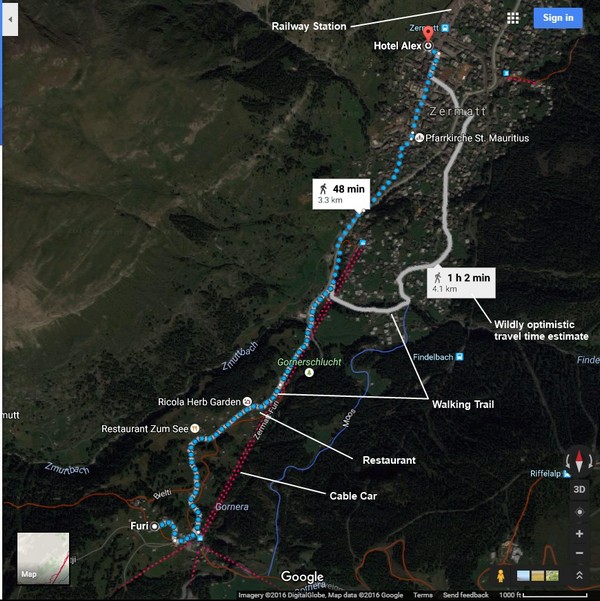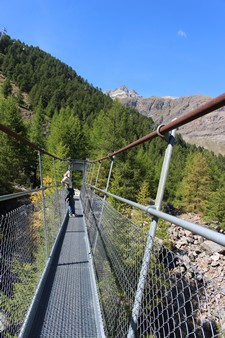
Rail Tour Through the Alps
(Note: Clicking on any image in this travelogue will bring up a full screen version of the image.)
Friday, September 2
Zermatt
I think Zermatt was my favorite place of the tour. And in large part because of the Hotel Alex. This establishment was built in 1960, and stands out from corporate high end hotels as something utterly unique. It was as if an innovative and talented architect who had never seen a hotel before in his life was given a huge budget, and told to design an attractive place for tourists to stay. The interior is done entirely in wood, with all surfaces covered in hand-carvings, no two of which are alike. The place is crammed with so much detail that the eye is overwhelmed. I'm not usually fond of busy interior decor, but somehow this place works for me. Every room is different. (Ours was a nice suite with a bedroom, living room, bath, and balcony.) The hotel is about a minute's walk from the train station, and right at the edge of the old town.
Hotel Alex
|
Perhaps one of the things that inspired the design was the preservationist mindset that pervades the town of Zermatt itself. Zermatt has taken Preservation to such an extent that it approaches the level of a religion. The banning of internal combustion vehicles is only one tiny morsel of the obsession. Literally no building may be torn down. And any repairs must be done only to restore the building exterior to its original appearance with no remodelling. Construction of the structure is done largely with the wood of the native larch trees, which, like cedar, is extremely resistant to rot. Extremely resistant. Some of the buildings are over 400 years old. The unfinished wood weathers to black, but steadfastly refuses to collapse. But interior surfaces not exposed to the weather, and sanded and oiled such as those in the public rooms of the Alex, glow with a rich sheen.
No modern electronic key cards for the Alex. Instead, you are handed a key affixed to a brass fob about the size and heft of a small bowling pin. Not something convenient to carry around in your pocket. So when you leave the hotel, you insert the room key into a lock identified by your room number on a large brass panel on the wall of the Reception Area (Photo #8). That allows you to turn another key on the panel just below your room key with a more practical fob that you can carry with you. Your room key is now trapped in its lock on the panel until you release it by inserting your travel key and turning it to lock it in the panel. Mid 20th Century technology, with is perhaps less convenient than an electronic key card, but somehow satisfying and charming.
Another quirky thing I loved about the place was the elevator. It was about the size of a closet (Max. capacity: 3 persons), and there was no sliding door on the car. You walk in the outer door, and push the button, expecting the car door to close, and the car to ascend. Instead, the car responds to the button by simply rising as you watch the smooth wall of the elevator shaft slide downwards in front of you. Not exactly OSHA compliant, but I loved it.
Zermatt Old Town
We had the whole day in Zermatt for a change. "Picturesque" doesn't begin to describe the town (Photo #9). Flowers bedeck the balconies and windowsills of every building (Photo #10). Of course, Zermatt is the gateway to the Matterhorn (Photo #11), which, once considered unassailable, is now climbed by scores of people every year. And a few still die in the attempt. We had a brief walking tour of the Old Town with a guide local to Zermatt. She informed us of the Preservationist culture of the City. Almost no structure is permitted to be torn down, and there are some centuries-old relics of no historical or cultural significance that resolutely refuse to collapse of their own weight, and may not be demolished. They are constructed of wood from the local larch trees, which, like cedar, may darken with age, but does not rot. And strict zoning statutes dictate that any new construction follow the design example of the old structures. So the town maintains its atmosphere, whether the building be relatively new (Photo#12), old but well-maintained (Photos #13 - 14), ancient (Photo #15 -- Note the makeshift prop for the balcony, probably installed sometime around 1650), or practically prehistoric, like the storage shed in Photo #16. (The mushroom-shaped stone corner supports are to foil hungry squirrels' getting at the corn in the shed.) The church has been lovingly restored inside and out (Photos # 17 - 18).
Jenny and I decided to take a little hike. We'd walk to the cable car terminus at the end of town, take that up to the first stop at the village of Furi, and then walk back down via a hiking trail which included a suspension bridge over a gorge of the River Moos. The map at the top of this page indicates that the walk back down was 4.1 kilometers (about 2-1/2 miles), and would take just over an hour. I don't know who they thought was doing the walking, but it sure wasn't me.
Zermatt to Furi and back by cable car and foot
 18. Suspension footbridge |
|||
|
|
||
We walked through the town to the top end where a cable car terminus was situated. A ten minute ride (Photo #16) took us to Furi, where a whole network of cable care lines led to numerous other peaks for extensive skiing in winter. But we disembarked in Furi, and sought out the walking trail back to Zermatt. The trail was quite steep in places, both uphill and down. We didn't need to walk far to get a view of the Furi cable car stop from a vantage point of 50 feet above (Photo #17). And from there it was only a short walk to the suspension footbridge we had been told about. See photos #18 & 19, and the video below. The bridge traversed a gorge I'd guess to be 500 to 800 feet deep, and gave the visual impression of being spindly and unsure. But in fact it was well braced, with secure guardrails, and quite stable. The main suspension cables are about an inch and 3/4 in diameter, and firmly anchored to bedrock. And while one could feel the footsteps of another person walking on the deck, the bridge did not sway or bounce or give any feeling of insecurity to anyone not significantly acrophobic. We spent some time just standing on the bridge, feeling the wind, and looking down at the gorge below. We fell into conversation with a young couple coming from the opposite side, waking up(!) the trail. He was Swiss, and she Italian, and we spent a few moments at mid-span in the inconsequential chat with strangers that often becomes a memorable moment of any journey, and proceeded on our own ways.
Crossing the suspension footbridge
On the far side of the bridge, we encountered a little entertainment provided for passers by in the form of a short zipline (Photo #20). And of course everyone had to give it a try. And then we commenced on our trek back to Zermatt. I don't know who determines the travel times that Google Maps cites for their searches, but it must be someone considerably more fit than I. Perhaps it was one of the young couple we encountered on the bridge. But it was more like 2-1/2 hours than the 1 hr, 2 min. quoted by Google. The nature of the trail changed from that of the upper slopes (Photo #20) to the lower (Photo #21) as we walked. The walk was rather strenuous, even downhill. And long before we got to the lower slopes, small respites like the bench overlooking the valley (Photo 24) beckoned enticingly. A little less than halfway down, we encountered a restaurant where we stopped for lunch. I was hungry, but the larger attraction was the opportunity to sit down for an extended period of time and rest my legs. I seriously considered the trout, which were kept penned in a small pool formed by a weir in a rivulet right in the restaurant's backyard. Pool to pan in a matter of seconds. But I had eaten trout for dinner only the previous night, so we settled on sharing a chicken caesar salad. Thus fortified, we proceeded onwards.
I spotted a Swiss rarity on the trail: an unmowed lawn in front of a house (Photo #25). The house did have an unoccupied appearance about it, but that was really no excuse. Photo #26 is labeled "Avalanche fencing". But you really can't see it unless you click the photo to view it full screen on a full-size monitor. If you look carefully, you will see way up at the top of the mountain, and on down the slope, an extensive series of sturdy fences designed to impede and break up snow slides that inevitably occur each winter. Those fences are firmly anchored to bedrock, and braced with steel cables similarly anchored every 15 feet or so to keep them upright against the avalanches.
At some point below the restaurant, the trail broke away from the glacier-fed stream it had followed down from the footbridge, and led eastward to the valley of the Moos River, which eventually ran through the center of Zermatt. In town, the river was tamed and confined between concrete banks (Photo #27), and ran next to a cemetery with graves abundantly decked with floral displays (Photo #28). Exhausted and aching from unaccustomed exertion, I thought to examine the facilities of the hotel Alex's pool and spa. (Jenny says, "Your repeated comments about your 'aching bones' would be somewhat amusing if you also mention that we chose the route at the suggestion of the lady at the hotel reception, who said, 'We call that the kindergarten-level hike.' That sounded perfect to us at the outset, taking into account that the place is her back yard, and the children have the constitution of goats.")
Pool and spa in the Hotel Alex
Like everything else in the Hotel Alex, the pool was unique, and pretty spiffy. Walls and ceiling were decorated with hand painted murals and stained glass panels. I swam a little, but then retired to the Jacuzzi to soak my aching bones. We had the place pretty much to ourselves at the late hour. I forget where we went for dinner that evening, but I do remember searching for and finding a gelato emporium where I topped off a perfect day with two scoops of cookies 'n cream.